
The Braconidae are a family of parasitoid wasps. After the closely related Ichneumonidae, braconids make up the second-largest family in the order Hymenoptera, with about 17,000 recognized species and many thousands more undescribed. One analysis estimated a total between 30,000 and 50,000, and another provided a narrower estimate between 42,000 and 43,000 species.

Epicopeiidae is a family of insects in the order Lepidoptera. They are known as oriental swallowtail moths as they closely resemble some oriental swallowtail butterflies. Epicopeiidae have highly varied structure in regards to body size and wing shape. Epicopeiidaen wing patterns are involved in complicated mimicry rings.
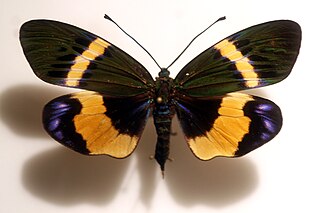
Chalcosiinae is a subfamily of the Zygaenidae, containing many species, mostly little known. Prominent sexual dimorphism, bright aposematic coloration and mimicry complexes are widespread.
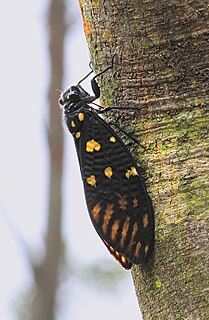
Gaeanini is a tribe of cicadas in the family Cicadidae, found in the Palearctic and Indomalaya. There are about 10 genera and at least 50 described species in Gaeanini.

Zanclognatha is a genus of litter moths of the family Erebidae. The genus was erected by Julius Lederer in 1857.

Sterrhinae is a large subfamily of geometer moths with some 3,000 described species, with more than half belonging to the taxonomically difficult, very diverse genera, Idaea and Scopula. This subfamily was described by Edward Meyrick in 1892. They are the most diverse in the tropics with the number of species decreasing with increasing latitude and elevation.
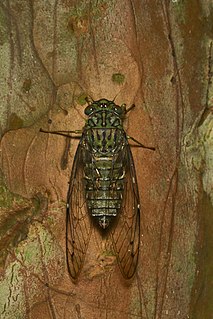
Purana is a genus of cicadas from Southeast Asia. Its distribution includes Java, Sumatra, Borneo, The Philippines, peninsular Malaysia, Thailand, India, Indochina, China, and Japan. Only one species has been recorded east of the Wallace Line, Purana celebensis, from Sulawesi. In all species the male possess two pairs of dark ventral abdominal tubercles on third and fourth sternites. The male opercula are rather short and generally do not reach beyond the posterior pair of tubercles. Related genera that also possess abdominal tubercles are Leptopsaltria, Maua, Nabalua and Tanna which together with Purana are in the subtribe Leptopsaltriina of the tribe Cicadini.

Cystomastacoides is a genus of parasitoid wasps belonging to the family Braconidae. It was named by Dutch entomologist Kees van Achterberg in 1997 from a single species Cystomastacoides coxalis discovered in Yunnan, China. There are only four species described in the genus, the other three having been reported on 19 March 2013. As typical ichneumon wasps, they are characterised by a deadly parasitoid behaviour. Their larvae grow inside the body of other insects, such as caterpillars, and feed on their internal organs inside the body until they emerge.
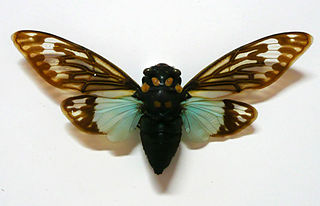
Distantalna splendida is a cicada species from Southeast Asia. It was previously placed in the genus Tosena. A characteristic that distinguishes Distantalna splendida from the Tosena species is the partly pale hyaline tegmina and wings. The species of Tosena do not have hyaline parts in the tegmina and wings. It has been recorded from India, Myanmar and Thailand.
Euterpnosia is a genus of cicada native to the island of Formosa, the Ryukyu Archipelago, Japan, Hainan and mainland Asia - China, Bhutan, Nepal and Vietnam. The type species is Euterpnosia chibensisMatsumura, 1917.

Formotosena seebohmi is a cicada species from Taiwan,China, Vietnam and Japan.

Angamiana is a genus of cicadas from Southeast Asia

Gaeana atkinsoni is a colourful cicada species and is the only member of the genus Gaeana that is found in southern India. Other species are found along the Himalayas and in Southeast Asia. It is endemic to the forests of the Western Ghats where it emerges in summer. Males are brightly coloured with a yellow and black forewing and a bright red hindwing that is visible in flight.

Dundubia is a genus of cicadas in the subfamily Cicadinae and the type genus of the tribe Dundubiini.

Sulphogaeana is a genus of cicadas found in Asia from the Himalayas east to Laos. They were earlier included in the genus Gaeana.
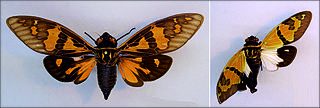
Callogaeana is a genus of Asian cicadas in the tribe Gaeanini. This genus includes species that were previously placed in Gaeana and sometimes known as known as "butterfly cicadas" due to their colourful wings.
Ambragaeana is a genus of Asian cicadas in the tribe Gaeanini. This genus was previously placed in Gaeana and species in this tribe are often called "butterfly cicadas" because of the colours and patterns of their wings.
Becquartina is a genus of Asian cicadas in the tribe Gaeanini and the monotypic subtribe Becquartinina. This genus includes species that were previously placed in Gaeana and are sometimes known as "butterfly cicadas" due to their colourful wings.















